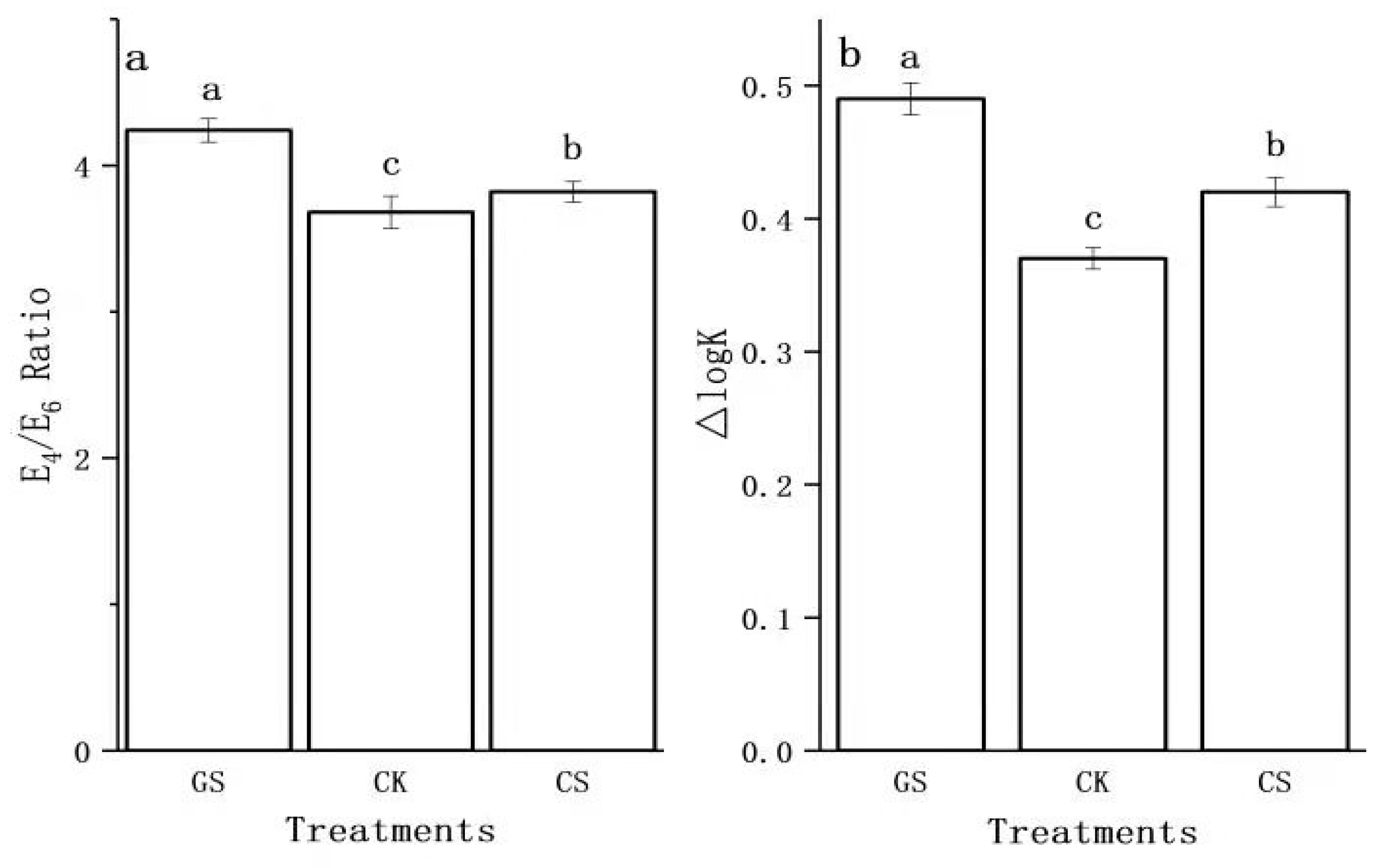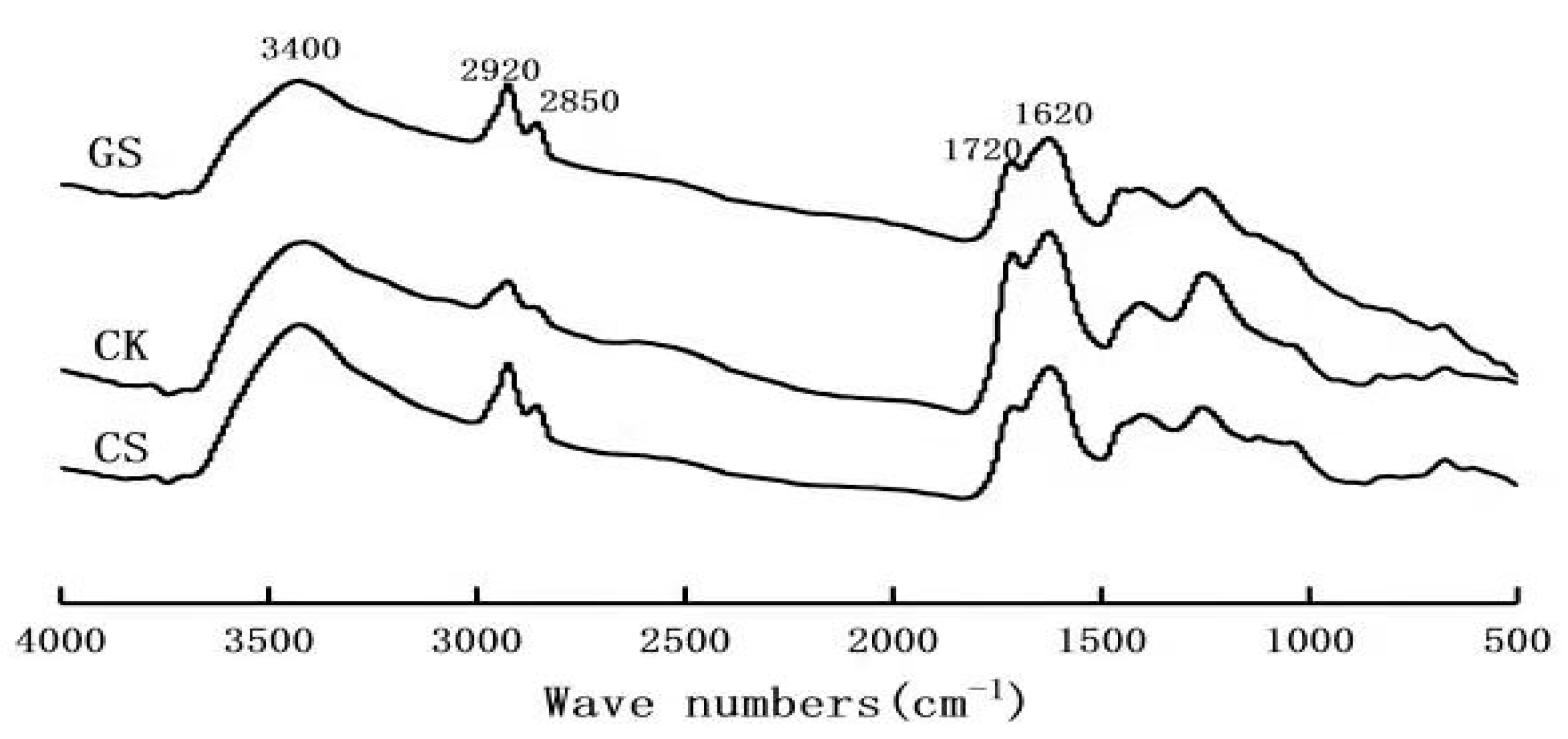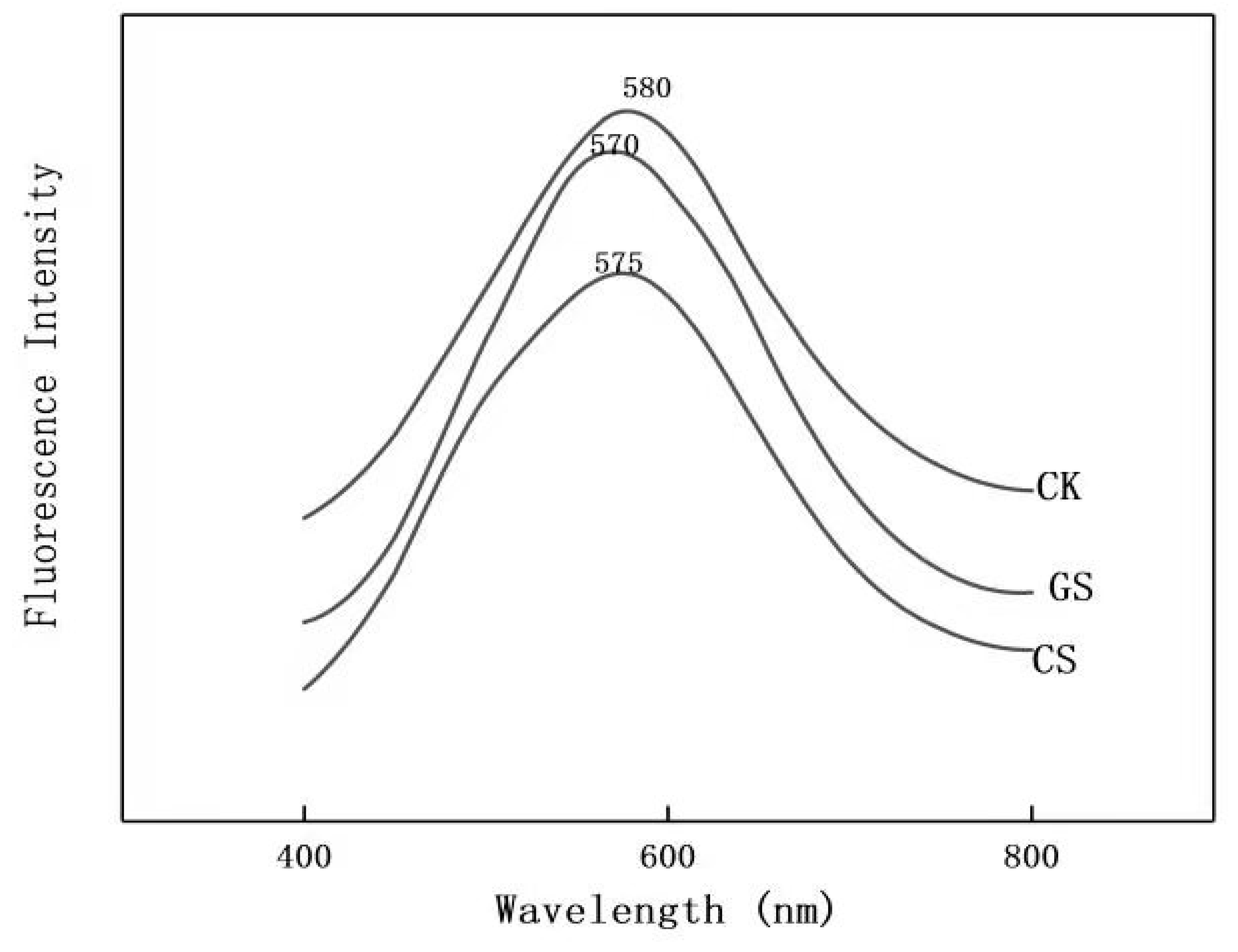Effects of Returning Granular Corn Straw on Soil Humus Composition and Humic Acid Structure Characteristics in Saline-Alkali Soil
Abstract
1. Introduction
2. Materials and Methods
2.1. Experimental Site
2.2. Experimental Design
2.3. Sample Determination
2.3.1. Extraction and Analysis of Humus
2.3.2. Isolation and Purification of HA
2.3.3. Infrared Spectrum Analysis
2.3.4. Principal Component Analysis (PCA)
2.3.5. Fluorescence Emission Spectrum Analysis
2.4. Data Analysis
3. Results
3.1. Humus Content and Composition
3.2. E4/E6 Ratios and △logK Values of HA
3.3. FTIR Spectrum of HA
3.4. PCA of Soil HA Infrared Spectroscopy
3.5. The Fluorescence Emission Spectra of HA
4. Discussion
5. Conclusions
Author Contributions
Funding
Acknowledgments
Conflicts of Interest
References
- Li, H. Evaluation on the Production of Food Crop Straw in China from 2006 to 2014. Bioenergy Res. 2017, 10, 949–957. [Google Scholar] [CrossRef]
- Fei, L.U.; Wang, X.; Han, B.; Ouyang, Z.; Duan, X. Soil carbon sequestrations by nitrogen fertilizer application, straw return and no-tillage in China’s cropland. Global Chang. Biol. 2009, 15, 281–305. [Google Scholar]
- Yin, H.; Zhao, W.; Li, T.; Cheng, X.; Liu, Q. Balancing straw returning and chemical fertilizers in China: Role of straw nutrient resources. Renew. Sustain. Energy Rev. 2017, 81, 2695–2702. [Google Scholar] [CrossRef]
- Frouz, J. Effects of soil macro- and mesofauna on litter decomposition and soil organic matter stabilization. Geoderma 2017, 332, 161–172. [Google Scholar] [CrossRef]
- Wood, S.A.; Tirfessa, D.; Baudron, F. Soil organic matter underlies crop nutritional quality and productivity in smallholder agriculture. Agric. Ecosyst. Envrion. 2018, 266, 100–108. [Google Scholar] [CrossRef]
- Yanagi, Y.; Shindo, H. Assessment of long-term compost application on physical, chemical, and biological properties, as well as fertility, of soil in a field subjected to double cropping. Agric. Sci. 2016, 07, 30–43. [Google Scholar] [CrossRef][Green Version]
- Adani, F.; Genevini, P.; Ricca, G.; Tambone, F.; Montoneri, E. Modification of soil humic matter after 4 years of compost application. Waste Manag. 2007, 27, 319–324. [Google Scholar] [CrossRef]
- Zhu, Q.T.; Shen, L.Y.; Qian, L.H.; Guo, S.W.; Dai, J.Y. Effects of organic material application on the structures of humic acids in low yield paddy soil. J. Soil Sci. Plant Nut. 2015, 21, 396–403. [Google Scholar]
- Xu, D.; Zhou, X.; Wang, X. Adsorption and desorption of Ni2+ on Na-montmorillonite: Effect of pH, ionic strength, fulvic acid, humic acid and addition sequences. Appl. Clay Sci. 2008, 39, 133–141. [Google Scholar] [CrossRef]
- Li, J.J.; Li, C.Z.; Gao, L.J.; Liu, B.S.; Liu, D.S.; Zou, G.Y. Impact of different organic fertilizers on soil humus, microbiomass and quality of cabbage. Adv. Mater. Res. 2014, 955, 628–632. [Google Scholar] [CrossRef]
- Rodríguez, F.J.; Schlenger, P.; García-Valverde, M. Monitoring changes in the structure and properties of humic substances following ozonation using UV-Vis, FTIR, and 1H NMR techniques. Sci. Total Environ. 2016, 541, 623–637. [Google Scholar] [CrossRef] [PubMed]
- Li, Q.; Sun, L.; Zhang, Y.; Qian, Y.; Zhai, J. Characteristics of equilibrium, kinetics studies for adsorption of Hg (II) and Cr (VI) by polyaniline/humic acid composite. Desalination 2011, 266, 188–194. [Google Scholar] [CrossRef]
- Kogut, B.M.; Sysuev, S.A.; Kholodov, V.A. Water stability and labile humic substances of typical chernozems under different land use. Eurasian Soil Sci. 2012, 45, 496–502. [Google Scholar] [CrossRef]
- Hu, J.; Wu, J.G.; Qu, X.J.; Li, J.M. Effects of organic wastes on structural characterizations of humic acid in semiarid soil under plastic mulched drip irrigation. Chemosphere 2018, 200, 313–321. [Google Scholar] [CrossRef] [PubMed]
- Yan, C.; Yan, S.S.; Jia, T.Y.; Dong, S.K.; Ma, C.M.; Gong, Z.P. Decomposition characteristics of rice straw returned to the soil in northeast China. Nutr. Cycl. Agroecosys. 2019, 114, 211–224. [Google Scholar] [CrossRef]
- Garnier, P.; Cambier, C.; Bousso, M.; Masse, D.; Chenu, C.; Recous, S. Modeling the influence of soil-plant residue contact on carbon mineralization: comparison of a compartmental approach and a 3d spatial approach. Soil Biol. Biochem. 2008, 40, 2754–2761. [Google Scholar] [CrossRef]
- Angers, D.A.; Recous, S. Decomposition of wheat straw and rye residues as affected by particle size. Plant Soil. 1997, 189, 197–203. [Google Scholar] [CrossRef]
- Yanardağ, I.H.; Zornoza, R.; Bastida, F.; Büyükkiliç-Yanardağ, A.; García, C.; Faz, A.; Mermut, A.R. Native soil organic matter conditions the response of microbial communities to organic inputs with different stability. Geoderma 2017, 295, 1–9. [Google Scholar] [CrossRef]
- Qadir, M.; Oster, J.D.; Schubert, S.; Noble, A.D.; Sahrawat, K.L. Phytoremediation of sodic and saline-sodic soils. Adv. Agron. 2007, 96, 197–247. [Google Scholar]
- Yang, J.; Zhang, S.; Li, Y.; Bu, K.; Zhang, Y.; Chang, L.; Zhang, Y. Dynamics of saline-alkali land and its ecological regionalization in western Songnen Plain, China. Chin. Geogr. Sci. 2010, 20, 159–166. [Google Scholar] [CrossRef]
- Guan, S.; Dou, S.; Chen, G.; Wang, G.; Zhuang, J. Isotopic characterization of sequestration and transformation of plant residue carbon in relation to soil aggregation dynamics. Appl. Soil Ecol. 2015, 96, 18–24. [Google Scholar] [CrossRef]
- Schollenberger, C.J. Determination of soil organic matter. Soil Sci. 1945, 59, 53–56. [Google Scholar] [CrossRef]
- Campitelli, P.; Ceppi, S. Effects of composting technologies on the chemical and physicochemical properties of humic acids. Geoderma 2008, 144, 325–333. [Google Scholar] [CrossRef]
- Sparks, D.L.; Helmke, P.A.; Page, A.L. Methods of Soil Analysis: Chemical Methods; American Society of Agronomy: Madison, WI, USA, 1996; No. 631.417/S736 V. 3. [Google Scholar]
- Cerli, C.; Celi, L.; Kaiser, K.; Guggenberger, G.; Zanini, E. Changes in humic substances along an age sequence of Norway spruce stands planted on former agricultural land. Org. Geochem. 2008, 39, 1269–1280. [Google Scholar] [CrossRef]
- Senesi, N.D.; Orazio, V.; Ricca, G. Humic acids in the first generation of eurosoils. Geoderma 2003, 116, 325–344. [Google Scholar] [CrossRef]
- Zhang, J.J.; Wang, L.B.; Li, C.L. Humus characteristics after maize residues degradation in soil amended with different copper concentrations. Plant Soil Environ. 2011, 56, 120–124. [Google Scholar] [CrossRef]
- Pechenizkiy, M.; Puuronen, S.; Tsymbal, A. The impact of sample reduction on PCA-based feature extraction for supervised learning, Acm Symposium on Applied Computing. ACM 2006, 553–558. [Google Scholar] [CrossRef]
- Cui, T.; Li, Z.; Wang, S. Effects of in-situ straw decomposition on composition of humus and structure of humic acid at different soil depths. J. Soil Sediment. 2017, 17, 2391–2399. [Google Scholar] [CrossRef]
- Al-Faiyz, Y.S.S. CPMAS 13C NMR characterization of humic acids from composted agricultural Saudi waste. Arab. J. Chem. 2017, 10, S839–S853. [Google Scholar] [CrossRef]
- Fan, W.; Wu, J.G.; Li, J.M.; Hu, J. Comparative effects of different maize straw returning modes on soil humus composition and humic acid structural characteristics in northeast China. Chem. Ecol. 2018, 34, 355–370. [Google Scholar] [CrossRef]
- Zhao, X.M.; He, L.; Zhang, Z.D.; Wang, H.B.; Zhao, L.P. Simulation of accumulation and mineralization (CO2 release) of organic carbon in chernozem under different straw return ways after corn harvesting. Soil Till. Res. 2016, 156, 148–154. [Google Scholar] [CrossRef]
- Maarastawi, S.A.; Frindte, K.; Geer, R.; Kröber, E.; Knief, C. Temporal dynamics and compartment specific rice straw degradation in bulk soil and the rhizosphere of maize. Soil Biol. Biochem. 2018, 127, 200–212. [Google Scholar] [CrossRef]
- Blagodatskaya, E.V.; Blagodatsky, S.A.; Anderson, T.H.; Kuzyakov, Y. Contrasting effects of glucose, living roots and maize straw on microbial growth kinetics and substrate availability in soil. Eur. J. Soil Sci. 2009, 60, 186–197. [Google Scholar] [CrossRef]
- Schneider, T.; Keiblinger, K.M.; Schmid, E.; Sterflinger-Gleixner, K.; Ellersdorfer, G.; Roschitzki, B.; Richter, A.; Eberl, L.; Zechmeister-Boltenstern, S.; Riedel, K. Who is who in litter decomposition? Metaproteomics reveals major microbial players and their biogeochemical functions. ISME J. 2012, 6, 1749. [Google Scholar] [CrossRef]
- Liu, X.; Zhou, F.; Hu, G.; Shao, S.; He, H.; Zhang, W.; Zhang, X.; Li, L. Dynamic contribution of microbial residues to soil organic matter accumulation influenced by maize straw mulching. Geoderma 2019, 333, 35–42. [Google Scholar] [CrossRef]
- Liu, S.; Zhang, Z.Y. Response of soil carbon dioxide fluxes, soil organic carbon and microbial biomass carbon to biochar amendment: a meta-analysis. GCB Bioenergy 2016, 8, 392–406. [Google Scholar] [CrossRef]
- Kardanpour, Z.; Jacobsen, O.S.; Esbensen, K.H. Soil heterogeneity characterization using PCA (Xvariogram)-Multivariate analysis of spatial signatures for optimal sampling purposes. Chemom. Intell. Lab. 2014, 136, 24–35. [Google Scholar] [CrossRef]
- Miano, T.M.; Senesi, N. Synchronous excitation fluorescence spectroscopy applied to soil humic substances chemistry. Sci. Total Environ. 1992, 117, 41–51. [Google Scholar] [CrossRef]
- Brunetti, G.; Plaza, C.; Clapp, C.E.; Senesi, N. Compositional and functional features of humic acids from organic amendments and amended soils in Minnesota, USA. Soil Biol. Biochem. 2006, 39, 1355–1365. [Google Scholar] [CrossRef]
- Zhang, J.J.; Cao, Z.Y.; Feng, G.Z.; Li, M.Y.; Li, C.L.; Gao, Q.; Wang, L.C. Effects of integrated soil-crop system management on soil organic carbon characteristics in a Primosol in Northeast China. Pedosphere 2017, 27, 957–967. [Google Scholar] [CrossRef]
- Jackson, L.E.; Calderon, F.J.; Steenwerth, K.L.; Scow, K.M.; Rolston, D.E. Responses of soil microbial processes and community structure to tillage events and implications for soil quality. Geoderma 2003, 114, 305–317. [Google Scholar] [CrossRef]
- Abiven, S.; Menasseri, S.; Chenu, C. The effects of organic inputs over time on soil aggregate stability—A literature analysis. Soil Biol. Biochem. 2009, 41, 1–12. [Google Scholar] [CrossRef]
- Bremer, E.; Houtum, W.; Kessel, C. Carbon dioxide evolution from wheat and lentil residues as affected by grinding, added nitrogen, and the absence of soil. Biol. Fert. Soils 1991, 11, 221–227. [Google Scholar] [CrossRef]
- Lou, Y.; Liang, W.; Xu, M.; He, X.; Wang, Y.; Zhao, K. Straw coverage alleviates seasonal variability of the topsoil microbial biomass and activity. Catena 2011, 86, 117–120. [Google Scholar] [CrossRef]





| Soil Alkali Hydrolyzable Nitrogen (g·kg−1) | Organic Matter (g·kg−1) | Available Phosphorus (mg·kg−1) | Available Potassium (mg·kg−1) | Total Salt (g·kg−1) | pH | Clay % | Silt % | Sand % |
|---|---|---|---|---|---|---|---|---|
| 11.28 ± 0.02 | 2.91 ± 0.03 | 20.61 ± 0.04 | 143.33 ± 2.32 | 3.39 ± 0.03 | 9.94 ± 0.05 | 40.5% | 18.3% | 41.2% |
| Materials | Organic Matter (g·kg−1) | Total Nitrogen (g·kg−1) | Total Phosphorus (g·kg−1) | Total Potassium (g·kg−1) | pH |
|---|---|---|---|---|---|
| Corn Straw and Granular Straw | 493 ± 2.16 | 8.33 ± 0.07 | 1.12 ± 0.02 | 12.3 ± 0.12 | 6.42 ± 0.08 |
| Treatments | HEC (g·kg−1) | HAC (g·kg−1) | FAC (g·kg−1) | HAC/FAC |
|---|---|---|---|---|
| CK | 0.819 ± 0.023 c | 0.366 ± 0.011 c | 0.453 ± 0.015 c | 0.808 ± 0.021 c |
| CS | 1.103 ± 0.027 b | 0.562 ± 0.013 b | 0.541 ± 0.014 b | 1.039 ± 0.014 b |
| GS | 1.297 ± 0.022 a | 0.711 ± 0.018 a | 0.586 ± 0.017 a | 1.213 ± 0.022 a |
| PC | Eigenvalues | Contribution Rate% | Accumulated Contribution Rate% |
|---|---|---|---|
| PC1 | 4.327 | 86.532 | 86.532 |
| PC2 | 0.613 | 13.462 | 99.994 |
| Treatments | Fluorescence Intensity |
|---|---|
| CS | 37.97 |
| CK | 42.3 |
| GS | 36.02 |
© 2020 by the authors. Licensee MDPI, Basel, Switzerland. This article is an open access article distributed under the terms and conditions of the Creative Commons Attribution (CC BY) license (http://creativecommons.org/licenses/by/4.0/).
Share and Cite
Chen, X.; Wu, J.; Opoku-Kwanowaa, Y. Effects of Returning Granular Corn Straw on Soil Humus Composition and Humic Acid Structure Characteristics in Saline-Alkali Soil. Sustainability 2020, 12, 1005. https://doi.org/10.3390/su12031005
Chen X, Wu J, Opoku-Kwanowaa Y. Effects of Returning Granular Corn Straw on Soil Humus Composition and Humic Acid Structure Characteristics in Saline-Alkali Soil. Sustainability. 2020; 12(3):1005. https://doi.org/10.3390/su12031005
Chicago/Turabian StyleChen, Xiaodong, Jinggui Wu, and Yaa Opoku-Kwanowaa. 2020. "Effects of Returning Granular Corn Straw on Soil Humus Composition and Humic Acid Structure Characteristics in Saline-Alkali Soil" Sustainability 12, no. 3: 1005. https://doi.org/10.3390/su12031005
APA StyleChen, X., Wu, J., & Opoku-Kwanowaa, Y. (2020). Effects of Returning Granular Corn Straw on Soil Humus Composition and Humic Acid Structure Characteristics in Saline-Alkali Soil. Sustainability, 12(3), 1005. https://doi.org/10.3390/su12031005




